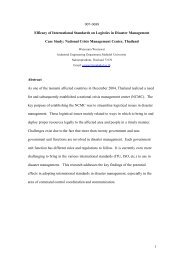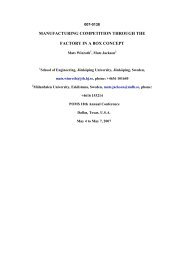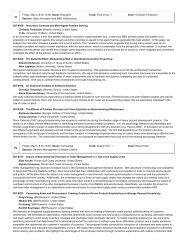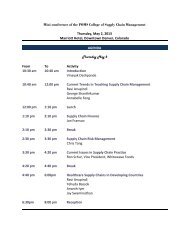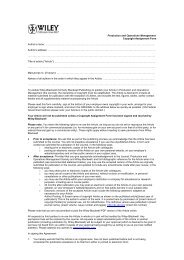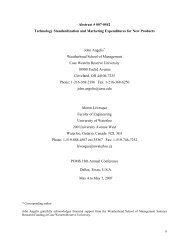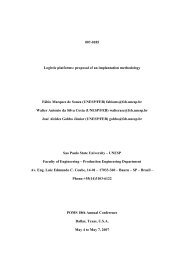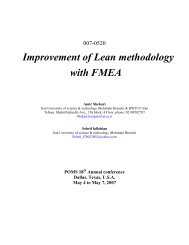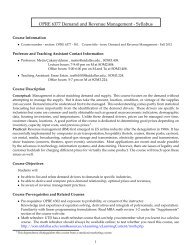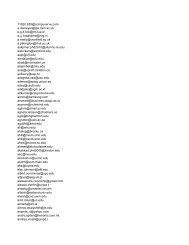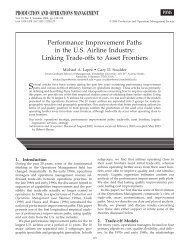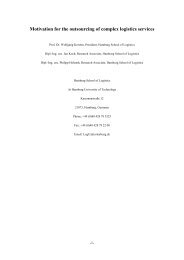007-0142 When the Sand Cone Model Meets SMEs Daisy ... - POMS
007-0142 When the Sand Cone Model Meets SMEs Daisy ... - POMS
007-0142 When the Sand Cone Model Meets SMEs Daisy ... - POMS
You also want an ePaper? Increase the reach of your titles
YUMPU automatically turns print PDFs into web optimized ePapers that Google loves.
<strong>007</strong>-<strong>0142</strong><br />
<strong>When</strong> <strong>the</strong> <strong>Sand</strong> <strong>Cone</strong> <strong>Model</strong> <strong>Meets</strong> <strong>SMEs</strong><br />
<strong>Daisy</strong> Wang<br />
Department of Management<br />
Sou<strong>the</strong>rn Illinois University<br />
Carbondale, IL 62901-4619<br />
daisyw74@siu.edu<br />
618-513-9296<br />
Suresh Tadisina<br />
Department of Management<br />
Sou<strong>the</strong>rn Illinois University<br />
Carbondale, IL 62901-4619<br />
suresht@cba.siu.edu<br />
618-453-3307<br />
<strong>POMS</strong> 18th Annual Conference<br />
Dallas, Texas, U.S.A.<br />
May 4 to May 7, 2<strong>007</strong>
Abstract<br />
The <strong>Sand</strong> <strong>Cone</strong> <strong>Model</strong> in operations strategy claims that firms following <strong>the</strong> unique<br />
sequence of <strong>the</strong> <strong>Sand</strong> <strong>Cone</strong> <strong>Model</strong> outperform those with o<strong>the</strong>r sequences. However, <strong>the</strong><br />
previous empirical focus was on large firms. With <strong>the</strong> flexibility and financial constraints<br />
that Small Medium Enterprises (<strong>SMEs</strong>) have, this paper attempts to explore <strong>the</strong><br />
possibility that <strong>SMEs</strong> and large firms are suitable for different types of strategies and<br />
<strong>SMEs</strong> are able to construct different strategic priorities without following <strong>the</strong> sequence<br />
suggested by <strong>the</strong> <strong>Sand</strong> <strong>Cone</strong> <strong>Model</strong>. We hope, through this paper, more research effort<br />
will be put in examining <strong>SMEs</strong> as <strong>the</strong>y play an important role in <strong>the</strong> global economy.<br />
Keywords:<br />
Small Medium Enterprises, <strong>SMEs</strong>, Manufacturing Strategy, Operations<br />
Strategy, <strong>Sand</strong> <strong>Cone</strong> <strong>Model</strong>, Flexibility, Competitive Priorities<br />
1
INTRODUCTION<br />
Operations strategy has been evolving and has been integrated with corporate<br />
strategies since Skinner (1969) first brought attention to operations strategy. Ferdows<br />
and De Meyer (1990) observed <strong>the</strong> phenomenon that conventional thoughts on <strong>the</strong> tradeoffs<br />
among competitive capabilities (Hayes & Wheelwright, 1984; Hill, 1985; Schmenner,<br />
1987) could be overcome through following a particular sequence of strategic priorities,<br />
called <strong>the</strong> <strong>Sand</strong> <strong>Cone</strong> <strong>Model</strong>. They used data from <strong>the</strong> European Manufacturing Futures<br />
Survey to test <strong>the</strong>ir model. However, <strong>the</strong> survey subjects were all large European<br />
manufacturers. It is questionable whe<strong>the</strong>r or not small firms can accumulate all four<br />
competitive capabilities, and moreover, if <strong>the</strong>y are able to have <strong>the</strong>se capabilities, will <strong>the</strong><br />
<strong>Sand</strong> <strong>Cone</strong> <strong>Model</strong> sequence apply to <strong>the</strong>m? Do small firms have to follow <strong>the</strong> sequence<br />
suggested in <strong>the</strong> <strong>Sand</strong> <strong>Cone</strong> <strong>Model</strong>? The goal of this paper is to examine <strong>the</strong>se questions<br />
by developing several propositions.<br />
<strong>SMEs</strong> have played critical roles in <strong>the</strong> global economy (Barad & Gien, 2001;<br />
Chen, 1999; Fiegenbaum & Karnani, 1991; Sherman, 1999; Sum, Kow, & Chen, 2004).<br />
The U.S. Commerce Department defines an SME as a company with less than 500<br />
employees (Clark, 2005). Almost half of <strong>the</strong> U.S. workforce is employed by <strong>SMEs</strong> and<br />
two-thirds of all employees in Europe work in <strong>SMEs</strong>. 97% of U.S. exporters are <strong>SMEs</strong>,<br />
and <strong>SMEs</strong> are responsible for more than one-fourth of U.S. exports. The number of SME<br />
exporters grew twice as fast as large exporters from 1992 to 2002 (Clark, 2005).<br />
Despite <strong>the</strong> importance of <strong>SMEs</strong> to <strong>the</strong> global economy, however, academia has<br />
not paid much attention to <strong>SMEs</strong>. Dangayach and Deshmukh (2001) suggest more<br />
research should be done on <strong>the</strong> “relevance of manufacturing strategy to <strong>SMEs</strong>”. In <strong>the</strong><br />
2
260 articles <strong>the</strong>y reviewed, less than 1% (2 articles) focused on <strong>the</strong> manufacturing<br />
strategies of <strong>SMEs</strong>. Therefore, this paper intends to contribute to <strong>the</strong> discussion on<br />
manufacturing strategies for <strong>SMEs</strong>. (Dangayach & Deshmukh, 2001)<br />
The <strong>Sand</strong> <strong>Cone</strong> <strong>Model</strong> suggests firms can develop all four sustainable competitive<br />
advantages through following a particular sequence of strategic priorities, while <strong>the</strong><br />
conventional trade-off <strong>the</strong>ory suggests firms will be better off if <strong>the</strong>y focus on one<br />
priority or a few priorities instead of all. The suggested sequence is: quality,<br />
dependability/flexibility 1 , speed, and cost efficiency. If firms follow this sequence of<br />
focus, <strong>the</strong>y will build up <strong>the</strong>ir advantages concerning all <strong>the</strong> elements. There is no tradeoff<br />
needed. On <strong>the</strong> contrary, if firms do not follow this sequence, it will be costly or<br />
difficult to enjoy all four competitive advantages at <strong>the</strong> same time (Ferdows and De<br />
Meyer, 1990).<br />
Ferdows and De Meyer (1990) developed this model observing <strong>the</strong> performance<br />
of large Japanese manufacturers and <strong>the</strong>n tested <strong>the</strong> model using data from large<br />
European firms. <strong>SMEs</strong> are considered weaker in <strong>the</strong> marketplace because of lack of<br />
managerial expertise, small bargaining power with suppliers and customers, few financial<br />
resources, but <strong>the</strong>y are usually more flexible than large firms and <strong>the</strong>ir decision-making<br />
process is typically efficient and effective (Ebben & Johnson, 2005; Fiegenbaum et al.,<br />
1991; Jarillo, 1989; Sherman, 1999). Some researches have generally concluded that<br />
strategies not only function differently in small firms than in large ones but also have<br />
different impacts (Fiegenbaum et al., 1991; Jarillo, 1989). This leads us to ask <strong>the</strong><br />
following research questions: Without following <strong>the</strong> suggested sequence by <strong>the</strong> <strong>Sand</strong><br />
1 In Ferdows and De Meyer’s (1990) paper, flexibility and dependability are used interchangeably. Later on, most<br />
scholars used flexibility.<br />
3
<strong>Cone</strong> <strong>Model</strong>, can <strong>SMEs</strong> accumulate all four manufacturing capabilities to gain<br />
competitive advantage? Are <strong>the</strong>re any performance differences between <strong>the</strong> <strong>SMEs</strong> using<br />
<strong>the</strong> <strong>Sand</strong> <strong>Cone</strong> <strong>Model</strong> sequence and those using o<strong>the</strong>r sequences?<br />
Previous studies seldom focused on manufacturing capabilities of <strong>SMEs</strong> when<br />
arguing which manufacturing strategy paradigm is <strong>the</strong> most appropriate, trade-offs or<br />
synergy. This paper will contribute to <strong>the</strong> field by first extending <strong>the</strong> <strong>Sand</strong> <strong>Cone</strong> <strong>Model</strong><br />
to <strong>SMEs</strong>. Second, we will focus on manufacturing strategy for <strong>SMEs</strong> specifically. We<br />
aim to explore <strong>the</strong> unique characteristics that <strong>SMEs</strong> have to differentiate <strong>the</strong>mselves from<br />
large firms and stay competitive. Third, through this paper, we hope to propose strategies<br />
more customized for <strong>SMEs</strong>.<br />
THEORETICAL BACKGROUND<br />
Manufacturing Strategy<br />
Skinner (1969) is considered <strong>the</strong> first one to define manufacturing strategy and<br />
called for attention to manufacturing in developing corporate strategy. After that, many<br />
scholars presented different views on manufacturing strategy. Voss (1995) stated that<br />
<strong>the</strong>re are three main streams in <strong>the</strong> manufacturing strategy literature: “competing through<br />
manufacturing,” “strategic choices in manufacturing strategy,” and “best practice.” In<br />
addition to those three, Gagnon (1999) added one more, a resource-based view of<br />
manufacturing. Flynn, Schroeder and Flynn (1999) used competitive priorities as <strong>the</strong>ir<br />
criteria to categorize manufacturing strategies into two main streams, <strong>the</strong> “trade-offs” and<br />
“synergy” streams. We will adopt this categorization in this paper. (Flynn, Schroeder, & Flynn, 1999)<br />
4
It is well-known that Porter (1980) suggested trade-offs in his low cost and<br />
differentiation strategies. Interestingly, <strong>the</strong> traditional trade-off manufacturing strategy<br />
originated from Skinner (1969). He suggested <strong>the</strong> need for focused factories where<br />
management should prioritize certain manufacturing advantages based on corporate<br />
strategies and expect “compromises or trade-offs to be made.” Hayes and Wheelwright<br />
(1984) presented four main process choices and suggested managers focus on one of<br />
<strong>the</strong>m in order to create competitive advantages for firms. Hill (1985) also emphasized<br />
“focused factories” while promoting order-winner and order-qualifier ideas. After<br />
identifying a firm’s order winners and qualifiers, <strong>the</strong> firm should attempt to synchronize<br />
process and infrastructures with strategic priorities (Hill, 1985). All <strong>the</strong>se are related to<br />
<strong>the</strong> concept of “trade-offs,” where firms have to “focus” or “prioritize” <strong>the</strong>ir pursuit of<br />
capabilities in order to create competitive advantages, and if <strong>the</strong>y try to have more than<br />
one priority, <strong>the</strong>y will lose focus and <strong>the</strong>n lose <strong>the</strong>ir edge.<br />
As global competition gets fierce, firms with <strong>the</strong> trade-offs strategy cannot hold<br />
sustainable competitive advantages for long. Therefore, firms have to create new<br />
competitive advantages (Gagnon, 1999). This is where “best practice” strategy comes in.<br />
A highly competitive firm might accumulate all strategic advantages instead of trading<br />
off priorities such as cost, quality, or delivery speed, as suggested by trade-offs <strong>the</strong>ory<br />
(Schonberger, 1986). “Best practice” strategy is also known as synergy strategy because<br />
in a globalized economy, firms have to build more than one competitive priority and if<br />
firms focus on one priority, it would eventually have to build more than one priority to be<br />
competitive enough to survive, especially in mature industries (Hill, 1988). Discussion<br />
on “best practice” strategy includes world class manufacturing, JIT (Just in Time), TQM<br />
5
(Total Quality Management), concepts from MRP (Materials Requirements Planning),<br />
OPT (Optimized Production Technology), FMS (Flexible Manufacturing Systems), and<br />
lean production. It is considered <strong>the</strong> most recent stream in manufacturing strategy (Voss,<br />
1995). As long as firms perform “<strong>the</strong> best” <strong>the</strong>y can outperform <strong>the</strong>ir competitors.<br />
It is still under debate whe<strong>the</strong>r synergy or trade-offs strategies lead firms to better<br />
performance. Is it possible to develop multiple capabilities? Are firms competitive<br />
enough if <strong>the</strong>y have one focused capability? The capabilities defined here refer to <strong>the</strong><br />
“realized” capabilities. It could be intended or unintended based on Resource-based<br />
View (RBV). Previous studies used large firms to empirically support <strong>the</strong>ir arguments.<br />
If it is questionable for large firms to develop multiple capabilities, how would this<br />
argument apply to small firms? The disadvantages small firms usually face are little<br />
bargaining power over suppliers and customers, fewer financial resources and less<br />
managerial expertise (Ebben et al., 2005; Fiegenbaum et al., 1991; Jarillo, 1989; Sherman,<br />
1999). With <strong>the</strong>se disadvantages, can small firms build multiple capabilities? In our<br />
opinion, <strong>the</strong>se disadvantages shape <strong>SMEs</strong> to be more agile in responding to<br />
environmental changes effectively. In order to survive in <strong>the</strong> competitive environment<br />
where large firms have more resources, <strong>SMEs</strong> are able to develop unique characteristics<br />
that help <strong>the</strong>m to survive and accordingly to build multiple capabilities.<br />
Proposition 1: <strong>SMEs</strong> are capable of accumulating all four manufacturing<br />
capabilities (cost, dependability, speed, and quality).<br />
The <strong>Sand</strong> <strong>Cone</strong> <strong>Model</strong> is <strong>the</strong> bridge between traditional trade-offs strategy and <strong>the</strong><br />
synergy strategy. The <strong>Sand</strong> <strong>Cone</strong> <strong>Model</strong> does not completely eliminate <strong>the</strong> possibility of<br />
trade-offs, while it claims that firms will be able to develop and retain <strong>the</strong> four main<br />
6
competitive advantages if <strong>the</strong>y follow <strong>the</strong> rigid sequence of priorities: quality,<br />
dependability, speed, and cost. This does not mean that o<strong>the</strong>r sequences are not possible,<br />
but it will be costly to build up all advantages through o<strong>the</strong>r sequences, or it will be more<br />
difficult to hold <strong>the</strong> four advantages stably for long duration (Ferdows and De Meyer,<br />
1990). Ferdows and De Meyer (1990) ga<strong>the</strong>red data from 167 large manufacturers in<br />
Europe and <strong>the</strong> data supported <strong>the</strong>ir arguments for <strong>the</strong> <strong>Sand</strong> <strong>Cone</strong> <strong>Model</strong>. However, <strong>the</strong>y<br />
did not obtain data from small and medium manufacturers, and <strong>the</strong>refore, <strong>the</strong> results<br />
cannot be extended to include <strong>SMEs</strong>. Rosenzweig and Roth (2004) supported <strong>the</strong><br />
arguments proposed by <strong>the</strong> <strong>Sand</strong> <strong>Cone</strong> <strong>Model</strong> in <strong>the</strong>ir empirical study of high-tech<br />
manufacturing firms. In <strong>the</strong>ir sample, <strong>the</strong>y included small firms but <strong>the</strong>ir focus was not<br />
on small firms but on <strong>the</strong> competitive progression <strong>the</strong>ory and <strong>the</strong>refore, <strong>the</strong> <strong>Sand</strong> <strong>Cone</strong><br />
<strong>Model</strong> effect for large firms and small firms was not distinguished.<br />
SME Manufacturing Strategy<br />
As mentioned above, <strong>SMEs</strong> have gradually become a vital part of <strong>the</strong> global<br />
economy (Barad et al., 2001; Chen, 1999; Fiegenbaum et al., 1991; Sherman, 1999; Sum<br />
et al., 2004). Little research is available discussing SME manufacturing strategy.<br />
Fiegenbaum and Karnani (1991) found that <strong>SMEs</strong> have different competitive advantages<br />
than large firms based on <strong>the</strong> data from more than 3000 companies that operated during<br />
1979-1987. They conclude that firm size is negatively correlated with output flexibility<br />
and in certain industries output flexibility is a more useful strategy.<br />
Ebben and Johnson (2005) specifically studied efficiency and flexibility in small<br />
firms, and using data from 200 firms, <strong>the</strong>y found that small firms with focus on efficiency<br />
or flexibility outperform those that mix <strong>the</strong>se two manufacturing priorities. Both<br />
7
efficiency-focused and flexibility-focused firms perform better than non-focused ones.<br />
However, <strong>the</strong>re was not enough evidence to show which strategy was <strong>the</strong> best for small<br />
firms as <strong>the</strong>re was no significant difference in firm performance between <strong>the</strong> efficiencyfocused<br />
and flexibility-focus strategies (Ebben and Johnson., 2005).<br />
Chen (1999) investigated 33 published case reports on SME operations in Taiwan<br />
and generated relationships between competitive priorities and strategic decisions. Sum<br />
et al. (2004), on <strong>the</strong> o<strong>the</strong>r hand, looked into Singapore’s high performing <strong>SMEs</strong> to<br />
develop a taxonomy of operations strategies. They formed three strategic clusters: allrounders,<br />
differentiators, and efficient innovators. All-rounders do not contain any<br />
operational advantage and rely on marketing more than operations for competitive<br />
advantages. Differentiators put quality as <strong>the</strong>ir strategic priority but suffer in high cost.<br />
Efficient innovators focus on innovations and cost efficiency and perform best financially<br />
among <strong>the</strong> three clusters (Sum et al., 2004). Kathuria (2000) conducted a similar study<br />
with 196 <strong>SMEs</strong> in <strong>the</strong> U.S. His study labels four clusters: starters, efficient conformers,<br />
speedy conformers and do all. Efficient conformers with strategic focus on quality and<br />
cost perform <strong>the</strong> best among all. He also points out that do all cluster puts a relatively<br />
high emphasis on all four priorities compared to o<strong>the</strong>r clusters. The author suggests <strong>the</strong>se<br />
firms might have progressed through <strong>the</strong> <strong>Sand</strong> <strong>Cone</strong> <strong>Model</strong> sequence and that is why this<br />
cluster can emphasize and enhance all four priorities simultaneously. However, when he<br />
measured <strong>the</strong> capabilities of <strong>SMEs</strong>, he actually applied <strong>the</strong> concept of “intended<br />
strategies”. He asked firms to rate how important <strong>the</strong>y perceived each capability.<br />
Therefore, <strong>the</strong> direct relationship between <strong>the</strong> <strong>Sand</strong> <strong>Cone</strong> <strong>Model</strong> sequence and <strong>the</strong> ability<br />
to develop all four capabilities was not explicitly considered.<br />
8
SME Flexibility<br />
Most manufacturing strategy scholars mention flexibility in <strong>the</strong>ir studies. In<br />
manufacturing strategy literature, flexibility refers to output flexibility. It is defined as<br />
<strong>the</strong> ability of a firm to introduce new designs or products into production quickly, to<br />
adjust capacity rapidly, to handle variations in customer orders, or to handle changes in<br />
customer delivery schedules. This output flexibility is one of <strong>the</strong> flexibilities firms could<br />
have, especially <strong>SMEs</strong>. Never<strong>the</strong>less, we are focusing on a broader definition of<br />
flexibility here. The flexibility <strong>SMEs</strong> have is defined as <strong>the</strong> ability to broadly respond to<br />
environmental uncertainty.<br />
Flexibility is considered <strong>the</strong> most valuable advantage <strong>SMEs</strong> have (Chen, 1999;<br />
Clark, 2005; Ebben et al., 2005; Pagell & Krause, 1999; Rasmusen & Zenger, 1987; Sum<br />
et al., 2004). In small firms, decision-making is more responsive to environmental<br />
changes compared to large firms (Fiegenbaum et al., 1991). Some researchers also point<br />
out that in small firms, <strong>the</strong>re are fewer agency problems than in large ones (Fiegenbaum<br />
et al., 1991; Rasmusen et al., 1987). Based on this argument, we think <strong>SMEs</strong> will be able<br />
to accumulate manufacturing capabilities through different sequences o<strong>the</strong>r than <strong>the</strong> one<br />
suggested by <strong>the</strong> <strong>Sand</strong> <strong>Cone</strong> <strong>Model</strong>.<br />
Proposition 2: <strong>SMEs</strong> accumulating all four manufacturing capabilities need not<br />
follow <strong>the</strong> <strong>Sand</strong> <strong>Cone</strong> <strong>Model</strong> sequence to have all four manufacturing capabilities.<br />
Based on research done by Fiegenbaum and Karnani (1991), <strong>SMEs</strong> have different<br />
competitive advantages than large firms and usually <strong>the</strong> flexibility strategy is more<br />
suitable to <strong>SMEs</strong> than to large firms. In addition, when Ferdows & De Meyer (1990)<br />
9
tested <strong>the</strong>ir <strong>Sand</strong> <strong>Cone</strong> <strong>Model</strong>, <strong>the</strong>y only ga<strong>the</strong>red data from large firms. No previous<br />
study has applied <strong>the</strong> <strong>Sand</strong> <strong>Cone</strong> <strong>Model</strong> to SME operations. With insufficient capital,<br />
<strong>SMEs</strong> typically focus on cost saving initially. As firms grow, strategies change to<br />
respond to market demand. However, <strong>the</strong> cost efficiency capability is already built.<br />
Even when <strong>SMEs</strong> try to focus on quality initially, cost efficiency is always part of <strong>the</strong>ir<br />
concern.<br />
Proposition 3: Cost efficiency is <strong>the</strong> first capability <strong>SMEs</strong> would build.<br />
Based on <strong>the</strong> <strong>Sand</strong> <strong>Cone</strong> <strong>Model</strong>, firms following <strong>the</strong> special sequence will<br />
perform better than those not following <strong>the</strong> sequence because it is less efficient and<br />
<strong>the</strong>refore cost more for those that do not follow <strong>the</strong> sequence to accumulate all four<br />
capabilities (Ferdows and De Meyer, 1990). Perhaps, large firms are rigid and not<br />
flexible enough to cope with <strong>the</strong> consequences of altering <strong>the</strong> sequence indicated in <strong>the</strong><br />
<strong>Sand</strong> <strong>Cone</strong> <strong>Model</strong>. With <strong>the</strong> flexibility <strong>SMEs</strong> have, we want to test whe<strong>the</strong>r <strong>SMEs</strong> are<br />
flexible enough to ignore <strong>the</strong> <strong>Sand</strong> <strong>Cone</strong> <strong>Model</strong> to accumulate all four strategic<br />
advantages and still perform well.<br />
Proposition 4: The performance of <strong>SMEs</strong> with <strong>the</strong> <strong>Sand</strong> <strong>Cone</strong> <strong>Model</strong> sequence<br />
will be similar to those without <strong>the</strong> <strong>Sand</strong> <strong>Cone</strong> <strong>Model</strong> sequence<br />
METHODOLOGY<br />
Rosenzweig and Roth (2004) conducted an empirical study to test <strong>the</strong> <strong>Sand</strong> <strong>Cone</strong><br />
<strong>Model</strong> effect. They used 81 high-tech firms as <strong>the</strong>ir sample and Structural Equation<br />
modeling (SEM) was adopted to test <strong>the</strong>ir hypo<strong>the</strong>ses. We plan to partially replicate <strong>the</strong>ir<br />
model. Their model included <strong>the</strong> four manufacturing capabilities, profitability, and two<br />
10
mediator variables (non-value-added and operational know-how). Our proposed model<br />
will not have <strong>the</strong> mediator variables and only contain <strong>the</strong> four manufacturing capabilities<br />
and profitability (Figure 1). Cost efficiency is <strong>the</strong> first capability <strong>SMEs</strong> pursue. There is<br />
no significant difference in <strong>the</strong> sequence of <strong>the</strong> o<strong>the</strong>r three capabilities and <strong>the</strong>refore, in<br />
our model, we arrange <strong>the</strong>m based on <strong>the</strong> <strong>Sand</strong> <strong>Cone</strong> <strong>Model</strong> sequence after we move <strong>the</strong><br />
cost efficiency to <strong>the</strong> first. SEM will be used to test <strong>the</strong> path model.<br />
Figure 1: Theoretical <strong>Model</strong><br />
M 1<br />
M 3<br />
M 9<br />
M 18<br />
M 5<br />
Cost<br />
X 1<br />
M 2<br />
M 4<br />
M 6<br />
M 8<br />
M 10<br />
M 12<br />
M 13<br />
M 15<br />
Quality<br />
Y 1<br />
Flexibility<br />
Y 2<br />
Profitability<br />
Y 4<br />
M 7<br />
M 16<br />
M 19<br />
M 11<br />
M 14<br />
M 17<br />
Speed<br />
Y 3<br />
• Data and Procedure<br />
To test <strong>the</strong> hypo<strong>the</strong>ses, we plan to use a convenience sample and mail out our<br />
survey to operations managers of 1000 <strong>SMEs</strong> from <strong>the</strong> list provided by <strong>the</strong> Chambers of<br />
Commerce in Midwestern states. An SME is defined as a company with less than 500<br />
11
employees according to <strong>the</strong> Department of Commerce. The questionnaire will be based<br />
on Kathuria (2000) and Rosenzweig and Roth (2004) and appropriately modified. After<br />
ga<strong>the</strong>ring data, we intend to use SEM to compare <strong>the</strong> base model and <strong>the</strong> modified<br />
models using <strong>the</strong> goodness of fit criteria and test our argument that <strong>the</strong> path suggested by<br />
<strong>the</strong> base model is <strong>the</strong> best compared to o<strong>the</strong>rs.<br />
• Measurement<br />
Manufacturing Capabilities<br />
The measurement of manufacturing capabilities is a modified version of<br />
Kathuria’s (2000) questionnaire. The original design had 17 items and we added 2 more<br />
items (M18, and M19 in Appendix A) to better represent our definition of strategic<br />
priorities as presented in Appendix A. In addition, we revise <strong>the</strong> wording from<br />
“perceived importance” to “capability” to capture <strong>the</strong> idea that perceived importance does<br />
not necessarily lead to capability. Rosenzweig and Roth’s (2004) measurement asked<br />
respondents to compare <strong>the</strong> four capabilities with <strong>the</strong> firm’s primary competitors.<br />
However, <strong>the</strong>y only asked one question for each capability. We think Kathuria’s (2000)<br />
instrument is more suitable for <strong>SMEs</strong> since many of <strong>the</strong>m are not familiar with academic<br />
strategy terms. Therefore, we combine <strong>the</strong>se two instruments by including 19 questions<br />
and asking respondents to rate <strong>the</strong> relative capabilities of <strong>the</strong>ir firms in comparison on<br />
<strong>the</strong>ir main competitors.<br />
Profitability<br />
Measuring firm performance has been one of <strong>the</strong> biggest challenges in strategy<br />
study. Conventionally, <strong>the</strong>re are two measurements used: profitability and productivity<br />
12
(Devaraj & Kohli, 2003). Most researchers evaluate firm performance through different<br />
ratios regarding profitability, such as return on assets (ROA), return on sales (ROS),<br />
operating income to asset (OI/A), operation income to sales (OI/S) etc. (Bharadwaj, 2000;<br />
Santhanam & Hartono, 2003; Wade & Hulland, 2004).<br />
However, <strong>SMEs</strong> are not as transparent in profit disclosure as <strong>the</strong> large firms.<br />
Researchers of <strong>SMEs</strong>, <strong>the</strong>refore, adopted ano<strong>the</strong>r method in evaluating firm performance,<br />
perceived performance (Chen, Chong, & Chen, 2000; Cragg, 2006; Ebben et al., 2005;<br />
Kathuria, 2000). Perceived performance information can be ga<strong>the</strong>red through surveys.<br />
CEOs or senior managers are asked to rate performance improvement after certain<br />
strategy is implemented or to rate perceived performance compared to industry average<br />
or main competitors (Chen et al., 2000; Cragg, 2006; Ebben et al., 2005; Kathuria, 2000).<br />
Ketokivi and Schroeder (2004) conducted a comparison study of perceived performance<br />
and financial performance and concluded that as long as common method variance<br />
(single respondent bias) can be avoided, perceived performance measurement is as<br />
representative as <strong>the</strong> financial figures. Based on <strong>the</strong> above reasons, we decided to use a<br />
perceived measurement of performance. In addition, Rosenzweig and Roth’s (2004)<br />
measurement of financial performance will be used.<br />
Discussion and Conclusion<br />
As information technology (IT) has evolved, <strong>the</strong> managements of <strong>SMEs</strong> are able<br />
to get information more easily than before on how large firms could run <strong>the</strong>ir business<br />
better. However, strategies suitable for large firms do not necessarily fit SME<br />
environments. Because of <strong>the</strong> importance of <strong>SMEs</strong> to <strong>the</strong> global economy and <strong>the</strong><br />
13
growing interest in entrepreneurship, this study attempts to provide direction for both<br />
academicians and practitioners of <strong>SMEs</strong> whe<strong>the</strong>r <strong>the</strong>y should follow <strong>the</strong> mainstream<br />
strategies. Prevalent strategies do not necessarily help <strong>SMEs</strong> achieve better performance.<br />
We hope this paper will draw more attention to issues pertaining to operations strategies<br />
in <strong>SMEs</strong> and more research will provide <strong>SMEs</strong> “customized” strategies.<br />
This paper serves both practitioners and academics. Managerially, we provide<br />
relevant discussion for SME practitioners to build <strong>the</strong>ir strategies. Academically, <strong>the</strong><br />
generalizability of <strong>the</strong> <strong>Sand</strong> <strong>Cone</strong> <strong>Model</strong> and its applicability to <strong>SMEs</strong> is examined.<br />
14
Appendix A:<br />
Please indicate for each question how strong you feel your business unit is relative to<br />
your primary competitors in <strong>the</strong> same markets (1=lower, 3=average, 5=market leader).<br />
Strategic priority survey 1 2 3 4 5<br />
• Cost efficiency<br />
M1 Controlling production costs<br />
M3 Improving labor productivity<br />
M9 Running equipment at peak efficiency<br />
M18 We plan our spending carefully<br />
• Quality<br />
M8 Ensuring conformance of final product to design specifications<br />
M10 Ensuring accuracy in manufacturing<br />
M12 Ensuring consistency in manufacturing<br />
M5 Manufacturing durable and reliable products<br />
M13 Making design changes in <strong>the</strong> product as desired by customer<br />
M15 Meeting and exceeding customer needs and preferences<br />
• Flexibility/Dependibility<br />
M4 Introducing new designs or new products into production quickly<br />
M6 Adjusting capacity rapidly within a short period<br />
M7 Handling variations in customer delivery schedule<br />
M2 Handling changes in <strong>the</strong> product mix quickly<br />
M16 Customizing product to customer specifications<br />
M19 Responding to market change faster than competitors<br />
• Delivery<br />
M14 Reducing manufacturing lead time<br />
M11 Meeting delivery dates<br />
M17 Making fast deliveries<br />
15
References<br />
Barad, M., & Gien, D. (2001), "Linking Improvement <strong>Model</strong>s to Manufacturing<br />
Strategies-A Methodology for <strong>SMEs</strong> and O<strong>the</strong>r Enterprises," International<br />
Journal of Production Research, 39, 12, 2675-2695.<br />
Bharadwaj, A.S. (2000), "A Resource-Based Perspective on Information Technology<br />
Capability and Firm Performance: An Empirical Investigation," MIS Quarterly,<br />
24, 1, 169-196.<br />
Chen, W.-H. (1999), "The Manufacturing Strategy and Competitive Priority of <strong>SMEs</strong> in<br />
Taiwan: A Case Survey," Asia Pacific Journal of Management, 16, 331-349.<br />
Chen, Y.-S., Chong, P.P., & Chen, J.C.-H. (2000), "Small Business Management: An IT-<br />
Based Approach," Journal of Computer Information Systems, 41, 2, 40-47.<br />
Clark, E. (2005), "Small & Medium-Sized Exporting Companies: A Statistical<br />
Handbook," In Department of Commerce (Ed.): Office of Trade and Industry<br />
Information.<br />
Cragg, P. (2006), "Strategies for Growth in <strong>SMEs</strong>: The Role of Information and<br />
Information Systems," Information Processing & Management, 42, 1, 320.<br />
Dangayach, G.S., & Deshmukh, S.G. (2001), "Manufacturing Strategy: Literature<br />
Review and Some Issues," International Journal of Operations and Production<br />
Management, 21, 7, 884-932.<br />
Devaraj, S., & Kohli, R. (2003), "Performance Impacts of Information Technology: Is<br />
Actual Usage <strong>the</strong> Missing Link?" Management Science, 49, 3, 273-289.<br />
Ebben, J.J., & Johnson, A.C. (2005), "Efficiency, Flexibility or Both? Evidence Linking<br />
Strategy to Performance in Small Firms," Strategic Management Journal, 26,<br />
1249-1259.<br />
Ferdows, K., & De Meyer, A. (1990), "Lasting Improvements in Manufacturing<br />
Performance: In Search of a New Theory," Journal of Operations Management, 9,<br />
2, 168-184.<br />
Fiegenbaum, A., & Karnani, A. (1991), "Output Flexibility-A Competitive Advantage for<br />
Small Firms," Strategic Management Journal, 12, 101-114.<br />
16
Flynn, B.B., Schroeder, R.G., & Flynn, E.J. (1999), "World Class Manufacturing: An<br />
Investigation of Hayes and Wheelwright's Foundation," Journal of Operations<br />
Management, 17, 249-269.<br />
Gagnon, S. (1999), "Resource-Based Competition and <strong>the</strong> New Operations Strategy,"<br />
International Journal of Operations and Production Management, 19, 2, 125-138.<br />
Hayes, R.H., & Wheelwright, S.C. (1984), Restoring Our Competitive Edge: Competing<br />
Through Manufacturing. New York: John Wiley.<br />
Hill, C.W.L. (1988), "Differentiation Versus Low Cost of Differentiation and Low Cost:<br />
A Contingency Framework," Academy of Management Review, 13, 401-412.<br />
Hill, T. (1985), Manufacturing Strategy. London: MacMillan.<br />
Jarillo, C. (1989), "Entrepreneurship and Growth: The Strategic Use of External<br />
Resources," Journal of Business Venturing, 4, 133-147.<br />
Kathuria, R. (2000), "Competitive Priorities and Managerial Performance: A Taxonomy<br />
of Small Manufacturers," Journal of Operations Management, 18, 627-641.<br />
Ketokivi, M., & Schroeder, R. (2004), "Manufacturing Practices, Strategic Fit and<br />
Performance A Routine-Based View," International Journal of Operations and<br />
Production Management, 24, 2, 171-191.<br />
Pagell, M., & Krause, D.R. (1999), "A Multiple-Method Study of Environmental<br />
Uncertainty and Manufacturing Flexibility," Journal of Operations Management,<br />
17, 307-325.<br />
Porter, M. (1980), Competitive Strategy. New York: The Free Press.<br />
Rosenzweig, E.D., & Aleda, V.R. (2004), "Towards a Theory of Competitive Progression:<br />
Evidence from High-Tech Manufacturing," Production and Operations<br />
Management, 13, 4, 354-368.<br />
Rasmusen, E., & Zenger, T. (1987), Firm Size and Agent Sorting, Working Paper, UCLA,<br />
LA, CA.<br />
Santhanam, R., & Hartono, E. (2003), "Issues in Linking Information Technology<br />
Capability to Firm Performance," MIS Quarterly, 27, 1, 125-153.<br />
Schmenner, R.W. (1987), Production/Operations Management. Chicago: Science<br />
Research Associates.<br />
Schonberger, R. (1986), World Class Manufacturing. New York: The Free Press.<br />
17
Sherman, H. (1999), "Assessing <strong>the</strong> Intervention Effectiveness of Business Incubation<br />
Programs on New Business Start-Ups," Journal of Developmental<br />
Entrepreneurship, 4, 117-133.<br />
Skinner, W. (1969), "Manufacturing-The Missing Link in Corporate Strategy," Harvard<br />
Business Review, 47, 3, 136-145.<br />
Sum, C.-C., Kow, L.S.-J., & Chen, C.-S. (2004), "A Taxonomy of Operations Strategies<br />
of High Performing Small and Medium Enterprises in Singapore," International<br />
Journal of Operations and Production Management, 24, 2, 321-345.<br />
Voss, C.A. (1995), "Alternative Paradigms for Manufacturing Strategy," International<br />
Journal of Operations and Production Management, 15, 4, 5-16.<br />
Wade, M., & Hulland, J. (2004), "Review: The Resource-Based View and Information<br />
Systems Research: Review, Extension, and Suggestions for Future Research [1],"<br />
MIS Quarterly, 28, 1, 107-142.<br />
18



